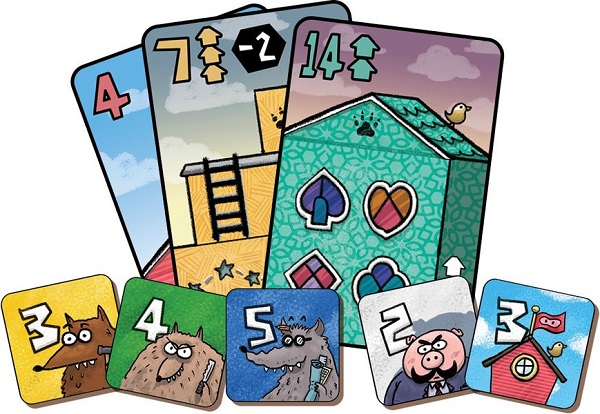Compete For Best Builder in The Three Little Wolves

The three little wolves are competing to build some ‘not so little’ buildings as they work hard to impress their boss, the big bad pig.
Published by Renegade Game Studios, The Three Little Wolves has a quirky theme and some clever gameplay, packed into a short and sweet twenty minutes.
Gameplay
Each player starts the game with a hand of five floor cards and three wolf tokens in their player color. On your turn, you may either play a card or discard a card.
When you play a card, you add it to the house you are building whose color matches that card’s color. There are three colors in the game, and each player may only build one house of each color. Some floor cards are white, and count as wild, and can be added to any house. When adding floor cards to a house, you must add it to the top of the building, and all cards must be in ascending numerical order (although these numbers do not need to be consecutive). There is, however, the exception of basements. Floor cards with the numerical values of one, two, and three, can instead be used as basements, with the values of B1, B2, and B3. Basements must be attached to buildings already under construction and are attached to the bottom of the building’s cards.
Some cards have bonuses or penalties for the end game if they are the final card on top of the building. Some cards also count as extra floors if they are at the top of a building. However, as soon as these cards are covered by more floors, these abilities and penalties are canceled out.
If you discard a card, you may choose to place one of your wolf tokens on an opponent’s house. Each house can only have one wolf token, except for a house with a B3 basement card; these can have two wolf tokens.
You end your turn by drawing a new card from the deck. If you draw a big bad pig card, you draw another card into your hand and then perform the big bad pig ability. First, you place a big bad pig token on the house that currently has the most floors. This token is worth points at the end of the game. Each house can only have one such token and the tokens that are placed later in the game are worth more points. Next, all players perform the action depicted on the big bad pig card drawn: either passing a card to an opponent or placing a wolf token in an opponent’s house.
There are three big bad pig cards in the game. When the third one is drawn, the ability on the card is ignored, each player has two more turns but does not draw any more cards, and then the game ends.
At the end of the game, the player with the tallest house in each color gets three points, while the player with the shortest house in each color has it demolished and removed from the game. Each non-demolished house is worth four points and each demolished house is worth negative one point. If a wolf token is at a demolished house, it earns its player negative one point, otherwise it is worth the number of points written on it (three to five). You also calculate any end-of-game scoring bonuses or penalties on the top card of each of your buildings. The player with the most points wins the game.

Review
The Three Little Wolves is a fun little card game, with interesting choices and enjoyable back and forth interaction between players. The tension comes in the direct competitiveness of trying to keep one step ahead of your opponents when it comes to the height of your buildings, while occasionally using your wolf tokens to piggy-back off their success.
You tend to have plenty of options on your turn, and finding the right time to play a wolf token is tricky. The wolves themselves lend the game an interesting dynamic to the gameplay and player interaction. If you think another player is pulling ahead in points and they’ve got a wolf on one of your houses, it may be worth it to lose that one point and try to get your house demolished in order to keep the point bonus away from them at the end.
The artwork is a unique style that might not appeal to everyone and might make some people mistake this for a children’s game, and while older children could certainly play this, this is a more 'thinky' game than might appeal to some kids. However, it’s fun to encounter a unique art style in gaming, and it fits with the theme quite well.
The Three Little Wolves is an excellent casual card game that is easy to teach, is highly playable, has a fun dynamic between players, and has an engaging scoring system that is not too complex.
Pros: Scoring is dependent on other players' buildings
Cons: Art style may not be for everyone and could mislead some players about the game’s target audience
Disclosure: we received a complimentary review copy of this game.







